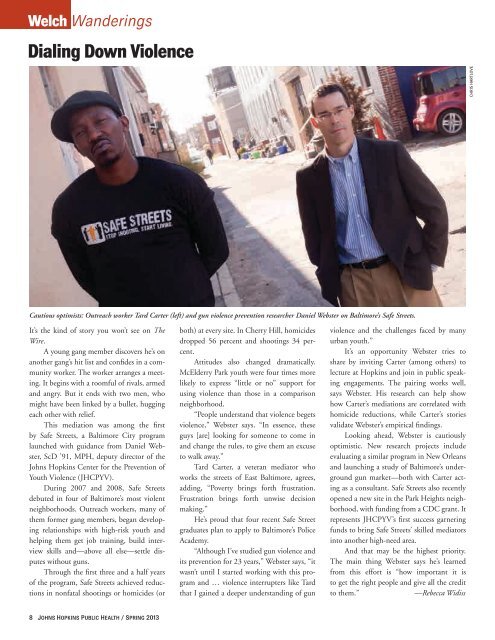this is global health
Download Low Resolution PDF - Johns Hopkins Public Health ...
Download Low Resolution PDF - Johns Hopkins Public Health ...
Create successful ePaper yourself
Turn your PDF publications into a flip-book with our unique Google optimized e-Paper software.
Welch Wanderings<br />
Dialing Down Violence<br />
chr<strong>is</strong> hartlove<br />
Cautious optim<strong>is</strong>ts: Outreach worker Tard Carter (left) and gun violence prevention researcher Daniel Webster on Baltimore’s Safe Streets.<br />
It’s the kind of story you won’t see on The<br />
Wire.<br />
A young gang member d<strong>is</strong>covers he’s on<br />
another gang’s hit l<strong>is</strong>t and confides in a community<br />
worker. The worker arranges a meeting.<br />
It begins with a roomful of rivals, armed<br />
and angry. But it ends with two men, who<br />
might have been linked by a bullet, hugging<br />
each other with relief.<br />
Th<strong>is</strong> mediation was among the first<br />
by Safe Streets, a Baltimore City program<br />
launched with guidance from Daniel Webster,<br />
ScD ’91, MPH, deputy director of the<br />
Johns Hopkins Center for the Prevention of<br />
Youth Violence (JHCPYV).<br />
During 2007 and 2008, Safe Streets<br />
debuted in four of Baltimore’s most violent<br />
neighborhoods. Outreach workers, many of<br />
them former gang members, began developing<br />
relationships with high-r<strong>is</strong>k youth and<br />
helping them get job training, build interview<br />
skills and—above all else—settle d<strong>is</strong>putes<br />
without guns.<br />
Through the first three and a half years<br />
of the program, Safe Streets achieved reductions<br />
in nonfatal shootings or homicides (or<br />
both) at every site. In Cherry Hill, homicides<br />
dropped 56 percent and shootings 34 percent.<br />
Attitudes also changed dramatically.<br />
McElderry Park youth were four times more<br />
likely to express “little or no” support for<br />
using violence than those in a compar<strong>is</strong>on<br />
neighborhood.<br />
“People understand that violence begets<br />
violence,” Webster says. “In essence, these<br />
guys [are] looking for someone to come in<br />
and change the rules, to give them an excuse<br />
to walk away.”<br />
Tard Carter, a veteran mediator who<br />
works the streets of East Baltimore, agrees,<br />
adding, “Poverty brings forth frustration.<br />
Frustration brings forth unw<strong>is</strong>e dec<strong>is</strong>ion<br />
making.”<br />
He’s proud that four recent Safe Street<br />
graduates plan to apply to Baltimore’s Police<br />
Academy.<br />
“Although I’ve studied gun violence and<br />
its prevention for 23 years,” Webster says, “it<br />
wasn’t until I started working with <strong>th<strong>is</strong></strong> program<br />
and … violence interrupters like Tard<br />
that I gained a deeper understanding of gun<br />
violence and the challenges faced by many<br />
urban youth.”<br />
It’s an opportunity Webster tries to<br />
share by inviting Carter (among others) to<br />
lecture at Hopkins and join in public speaking<br />
engagements. The pairing works well,<br />
says Webster. H<strong>is</strong> research can help show<br />
how Carter’s mediations are correlated with<br />
homicide reductions, while Carter’s stories<br />
validate Webster’s empirical findings.<br />
Looking ahead, Webster <strong>is</strong> cautiously<br />
optim<strong>is</strong>tic. New research projects include<br />
evaluating a similar program in New Orleans<br />
and launching a study of Baltimore’s underground<br />
gun market—both with Carter acting<br />
as a consultant. Safe Streets also recently<br />
opened a new site in the Park Heights neighborhood,<br />
with funding from a CDC grant. It<br />
represents JHCPYV’s first success garnering<br />
funds to bring Safe Streets’ skilled mediators<br />
into another high-need area.<br />
And that may be the highest priority.<br />
The main thing Webster says he’s learned<br />
from <strong>th<strong>is</strong></strong> effort <strong>is</strong> “how important it <strong>is</strong><br />
to get the right people and give all the credit<br />
to them.”<br />
—Rebecca Wid<strong>is</strong>s<br />
8 JOhns hOpkins public healTh / spRing 2013


